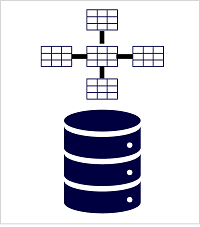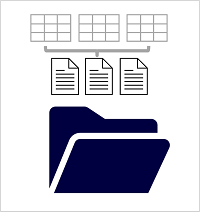Explore analytical data stores
There are two common types of analytical data store.
Data warehouses

A data warehouse is a relational database in which the data is stored in a schema that is optimized for data analytics rather than transactional workloads. Commonly, the data from a transactional store is transformed into a schema in which numeric values are stored in central fact tables, which are related to one or more dimension tables that represent entities by which the data can be aggregated. For example a fact table might contain sales order data, which can be aggregated by customer, product, store, and time dimensions (enabling you, for example, to easily find monthly total sales revenue by product for each store). This kind of fact and dimension table schema is called a star schema; though it's often extended into a snowflake schema by adding additional tables related to the dimension tables to represent dimensional hierarchies (for example, product might be related to product categories). A data warehouse is a great choice when you have transactional data that can be organized into a structured schema of tables, and you want to use SQL to query them.
Data lakes

A data lake is a file store, usually on a distributed file system for high performance data access. Technologies like Spark or Hadoop are often used to process queries on the stored files and return data for reporting and analytics. These systems often apply a schema-on-read approach to define tabular schemas on semi-structured data files at the point where the data is read for analysis, without applying constraints when it's stored. Data lakes are great for supporting a mix of structured, semi-structured, and even unstructured data that you want to analyze without the need for schema enforcement when the data is written to the store.
Hybrid approaches
You can use a hybrid approach that combines features of data lakes and data warehouses in a data lakehouse. The raw data is stored as files in a data lake, and Microsoft Fabric SQL analytics endpoints expose them as tables, which can be queried using SQL. When you create a Lakehouse with Microsoft Fabric, a SQL analytics endpoint is automatically created. Data lakehouses are a relatively new approach in Spark-based systems, and are enabled through technologies like Delta Lake; which adds relational storage capabilities to Spark, so you can define tables that enforce schemas and transactional consistency, support batch-loaded and streaming data sources, and provide a SQL API for querying.
Azure services for analytical stores
On Azure, there are several services that you can use to implement a large-scale analytical store including:
![]() Microsoft Fabric is a unified, end-to-end solution for large scale data analytics. It brings together multiple technologies and capabilities, enabling you to combine the data integrity and reliability of a scalable, high-performance SQL Server based relational data warehouse with the flexibility of a data lake and open-source Apache Spark. It also includes native support for log and telemetry analytics with Microsoft Fabric Real-Time Intelligence, as well as built in data pipelines for data ingestion and transformation. Each Microsoft Fabric product experience has its own home, for example the Data Factory Home. Each Fabric Home displays the items that you create and have permission to use from all the workspace that you access. Microsoft Fabric is a great choice when you want to create a single, unified analytics solution.
Microsoft Fabric is a unified, end-to-end solution for large scale data analytics. It brings together multiple technologies and capabilities, enabling you to combine the data integrity and reliability of a scalable, high-performance SQL Server based relational data warehouse with the flexibility of a data lake and open-source Apache Spark. It also includes native support for log and telemetry analytics with Microsoft Fabric Real-Time Intelligence, as well as built in data pipelines for data ingestion and transformation. Each Microsoft Fabric product experience has its own home, for example the Data Factory Home. Each Fabric Home displays the items that you create and have permission to use from all the workspace that you access. Microsoft Fabric is a great choice when you want to create a single, unified analytics solution.
 Azure Databricks is an Azure implementation of the popular Databricks platform. Databricks is a comprehensive data analytics solution built on Apache Spark, and offers native SQL capabilities as well as workload-optimized Spark clusters for data analytics and data science. Databricks provides an interactive user interface through which the system can be managed and data can be explored in interactive notebooks. Due to its common use on multiple cloud platforms, you might want to consider using Azure Databricks as your analytical store if you want to use existing expertise with the platform or if you need to operate in a multicloud environment or support a cloud-portable solution.
Azure Databricks is an Azure implementation of the popular Databricks platform. Databricks is a comprehensive data analytics solution built on Apache Spark, and offers native SQL capabilities as well as workload-optimized Spark clusters for data analytics and data science. Databricks provides an interactive user interface through which the system can be managed and data can be explored in interactive notebooks. Due to its common use on multiple cloud platforms, you might want to consider using Azure Databricks as your analytical store if you want to use existing expertise with the platform or if you need to operate in a multicloud environment or support a cloud-portable solution.
Note
Each of these services can be thought of as an analytical data store, in the sense that they provide a schema and interface through which the data can be queried. In many cases however, the data is actually stored in a data lake and the service is used to process the data and run queries. Some solutions might even combine the use of these services. An extract, load, and transform (ELT) ingestion process might copy data into the data lake, and then use one of these services to transform the data, and another to query it. For example, a pipeline might use a notebook running in Azure Databricks to process a large volume of data in the data lake, and then load it into tables in a Microsoft Fabric Warehouse.